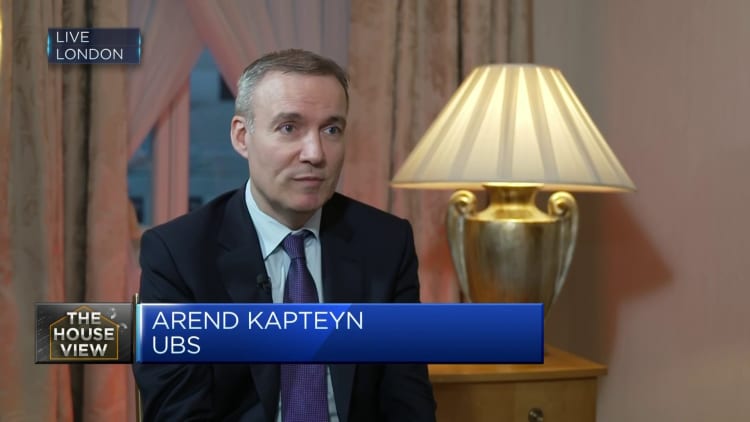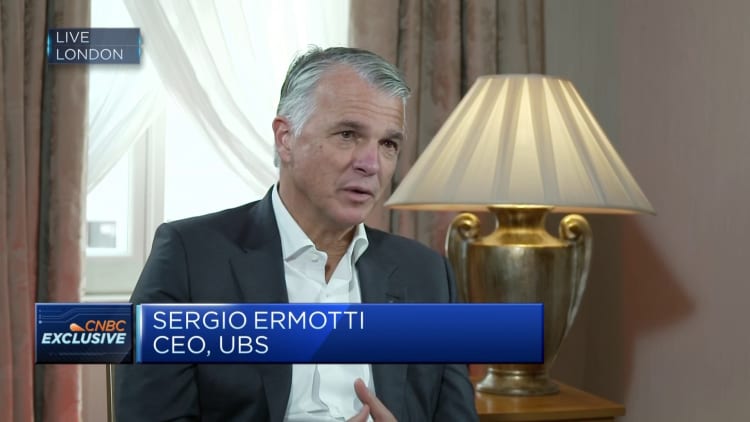Finance
We’re not headed for another global financial crisis, top UBS economist says after recession warning

Despite indicators like U.S. credit card debt pointing toward financial and economic pressures, another global financial crash is not imminent, UBS chief U.S. economist Jonathan Pingle believes.
U.S. credit card debt soared to $1.08 trillion in the third quarter of 2023, data from the Federal Reserve Bank of New York showed earlier this month. This has sparked concerns about what rising debt levels, brought on at least in parts by higher prices, could mean for the overall economy.
However, Pingle told CNBC’s Joumanna Bercetche on Wednesday that it is difficult to view the data as a systemic risk.
“I don’t think we’re facing the next GFC [global financial crisis],” he said on the sidelines of the UBS European Conference.
Credit tightening does play a role when it comes to the lag of Federal Reserve monetary policy filtering through to the economy, Pingle suggested. “We are still waiting to see those credit headwinds dampen activity in 2024,” he said.
Credit tightening tends to precede loan growth by several quarters, so the full impact is not yet clear, he explained.

Several other factors also come into play, Pingle noted. This includes concerns about regulation in the wake of the collapse of Silicon Valley Bank, which raised alarms about the health and stability of the banking sector and prompted a crisis in regional banking, and “rapid” interest rate hikes, he said.
The Federal Reserve began hiking interest rates in March 2022 in an effort to ease inflation and cool the economy. Eleven rate hikes have been implemented since then, with the target range for the fed funds rate rising from 0%-0.25% to 5.25%-5.5%.
The Fed chose to leave rates unchanged at both of its last two meetings, and Tuesday’s lower-than-expected reading of the October consumer price index prompted traders to all but erase the chances of rates being hiked at the central bank’s December meeting.
The CPI was flat compared to September and reflected a 3.2% rise on an annual basis, while the so-called core-CPI, which excludes food and energy prices, came in at 4% year over year. This marked the smallest rise since September 2021.
“It’s great news for the Federal Reserve in their quest to restore price stability,” Pingle told CNBC on Wednesday. Still, they are “not out of the woods yet” he added, saying that there was “still a ways to go” before the Fed reached its 2% inflation goal.
A trend of disinflation is however in place, Pingle said, and if the Fed can slow the economy, it could make strong progress toward its inflation goal.
“We think its probably going to get to 2 next year. It’s already falling faster than the Fed expects,” he said.
However the economy including the labor market will have to weaken further for inflation to steadily remain around 2%, Pingle expects.

“The path to two and a half we think is pretty clear, but sort of that last leg down we do think is going to take some weakening in the labor market,” he said.
In its 2024-2026 outlook for the U.S. economy, which was published Monday, UBS said it expected unemployment to rise close to 5% next year and for the economy to enter a mild recession. UBS is anticipating a contraction of the economy by around half a percentage point in mid-2024, its report suggested.
A looming recession has been a key fear among investors throughout the Fed’s rate-hiking cycle as many have been concerned about rates being hiked too high, too quickly.
They have therefore been hoping for an imminent end to rate hikes and hints about when the Fed may start cutting rates again.
UBS foresees significant rate cuts for 2024, predicting that rates could be cut by as many as 275 basis points throughout the year.
Rates would be cut “first to prevent the nominal funds rate from becoming increasingly restrictive as inflation falls, and later in the year to stem the economic weakening,” the Swiss bank said.
Rate cuts will therefore be a two-step process Pingle explained, and could start relatively early in the year.
“As early as March they should probably start at least calibrating the nominal funds rate,” he said, whereas the second stage would likely begin when unemployment starts rising.

Finance
Canada government adrift after finance minister resigns, Trump tariffs loom

By David Ljunggren
OTTAWA (Reuters) – The abrupt resignation of Canada’s finance minister leaves the government adrift less a month before the inauguration of a new U.S. administration that could impose crippling sanctions on Canadian exports.
Chrystia Freeland quit on Monday after Prime Minister Justin Trudeau offered her a lesser position. She said his wish to increase spending could endanger Canada’s ability to withstand the damage done by the tariffs that U.S. President-elect Donald Trump is threatening to impose.
Freeland had headed a special cabinet committee on Canada-U.S. relations and was working closely with the 10 provinces to ensure a united response.
“As a country we have to project strength and unity, and it’s chaos right now up in Ottawa,” Ontario Premier Doug Ford said after a scheduled online conference call of provincial premiers on Monday to discuss the U.S. threat.
An unimpressed Alberta premier, Danielle Smith, one of Trudeau’s biggest domestic critics, said the provincial leaders had only learned halfway through their call that the point person on Canada-U.S. relations had quit.
“It’s chaos. I’d be looking at this wondering who the next leader is … are they going to be able to bring forward a coherent plan? Is there going to be a team that is able to do a Team Canada approach?” she said.
“It’s not the greatest time to have a vacuum,” she added, calling for a national election to help restore stability.
Unhappy legislators from the ruling Liberal Party, some of whom have been calling on Trudeau to quit for months, met on Monday in Ottawa to vent their frustration.
The Liberals are trailing badly in the polls ahead of an election that must be held by late October 2025. Trudeau has until now ruled out the idea of resigning but if pressure on him mounts significantly, the results could be unpredictable.
“Trump will be inaugurated in 34 days. Canada must have a stable government,” former Trudeau foreign policy advisor Roland Paris said in a post on X.
When Trump came to power in 2017 he vowed to tear up the trilateral free trade treaty with Canada and Mexico. Freeland, who was then foreign minister, played a large role in helping renegotiate the pact and saving Canada’s economy, which is heavily reliant on the United States.
Vincent Rigby, a former national security and intelligence adviser to Trudeau, said Freeland’s departure meant the Canadian stance with Trump was up in the air.
“This is going to be quite problematic for the prime minister from a political perspective, but it’s now also going to be problematic in terms of how the Canadian government deals with an incoming Trump presidency,” he said on the sidelines of an event in Washington.
Finance
By denying Adams funds, the undemocratic Campaign Finance Board is election-meddling

The unelected city Campaign Finance Board just denied Mayor Adams access to more than $4 million in matching funds for his reelection fight — showing yet again the profoundly undemocratic nature of New York’s public-campaign-finance system.
The board declared Adams ineligible to receive public monies on the strength of alleged crimes and corruption, yet his trial on federal charges — and thus any factual finding of guilt — won’t even start until April.
And those charges themselves sure look like they’re motivated by politics (i.e. payback to Adams for challenging President Biden on the border crisis).
Yes, when it comes to the public fisc, even the appearance of impropriety is supposed to be a big no-no.
And Adams can appeal the decision; he still has millions in his war chest; etc. etc.
But this is at least a serious wound to his candidacy.
Again, at the hands of the CFB, which is neither directly elected nor remotely answerable to the voters of New York, nor really to anyone.
Yet it behaves as though it has the public mandate to shape and even decide election outcomes.
Consider the 2013 mayoral race: The CFB suddenly denied matching funds to then-Comptroller John Liu over alleged corruption, too — and so cleared the left lane of the Democratic primary (and near-certain victory in the general election) for a lumbering, communist-loving dimwit from Cambridge, Bill de Blasio.
That proved to be deeply consequential for all New Yorkers, eventually ushering in an era of high crime, failing schools, COVID insanity and general civic decay.
(The CFB also impacted the mayoral race in 2000, by the way, making up rules on the fly about what funds could go out the door for what after the 9/11 attacks forced a postponement of the primaries.)
Now all the leftists taking aim at Adams are jumping with joy over this decision.
The matching-funds rules themselves increase the field of candidates who’ve learned how to work the public-finance system, paying out an unthinkably lavish $8 for each (apparently) qualifying $1 in donations.
All on the taxpayers’ dime.
New York City progressives love to scream and shout that democracy is under threat.
Whatever happens in Adams’ case, the latest CFB intervention is a reminder the progressive idea of democracy often isn’t very democratic at all.
Finance
Global Paychecks: Personal Finance Tips From The Remote Work Boom

Work from anywhere. Rear view of young woman, female freelancer in straw hat working on laptop, … [+]
Right now, in Río Tercero, a small city in Argentina near Córdoba, Virginia More works with Pinterest as a software engineer, bridging her local experience with cutting-edge Silicon Valley projects. Similarly, Luis Ramos Paco, from Santiago de Llallagua, Bolivia—where growing potatoes and raising animals is necessary to provide for one’s family—now works with a US-based SaaS client to update its legacy system with a friendlier UI.
The remote work revolution has opened doors for skilled professionals like Virginia and Luis worldwide. Companies like BairesDev– which connects Latin American talent with U.S. tech firms– are bridging global income gaps and allowing tech talent and software engineers into an increasingly globalized job market while staying close to their families and communities.
“The region offers a rapidly expanding talent pool, strong cultural alignment, and geographical proximity to the U.S.,” Nacho De Marco, CEO and Co-Founder of BairesDev, explains. “This facilitates seamless real-time collaboration and efficient workflows. 33% of U.S. businesses now want to outsource their business operations to a country that’s close by. Professionals from Latin America have a similar work culture to their North American neighbors and possess a high level of English proficiency.”
As a result of this type of demand, many BairesDev workers who once faced limited opportunities in rural areas now earn between $30,000 and $80,000 annually, placing them in the top 5% of earners in their home countries.
Other companies like Toptal and Adeva work in similar ways to connect talented and skilled individuals to job opportunities around the world, breaking down barriers to entry and revitalizing local economies.
If you’re considering a remote job that can connect you to a different corner of the global marketplace, here are some important things to consider as you embark on your job hunt.
Earn Globally, Live Locally
One of the most significant advantages of remote work is the ability to earn in a high-income market while living in a lower-cost region. BairesDev, for instance, has had more than 6,000 of its Latin American-based workers integrate with teams in U.S. companies, like Google and Pinterest.
“During recruitment, we focus on a candidate’s competence over their credentials,” explains De Marco. “We also prioritize the future potential that someone can bring, in addition to their current skillset. This approach means discovering exceptional talent from diverse and often overlooked sources. Historically, around 40% of our developers come from non-metropolitan areas.”
Yes, that means you can live a balanced lifestyle in a quaint town like San Miguel de Allende while working with a U.S.-based tech giant.
Earning a higher paycheck while keeping your cost of living steady provides wealth-building opportunities, allowing you to build an emergency fund, pay off debt, and invest in property and other assets. Be sure to cross check the purchasing power of the currency you’ll be paid in to that of your local currency to ensure that you’re maximizing your potential earnings. Also make sure that the salary you’re being offered is fair compared to what employees at the company’s headquarters are making.
Track Finances Carefully
Once you’ve secured your remote job, you’ll want to set up a financial plan to ensure that you are maximizing your global paycheck without running into any snags. Opening a multi-currency bank account can help you minimize exchange rate losses and transfer fees, and many offer automations to make conversions between currencies seamless.
Also make sure to budget for any potential fluctuations in the foreign currency, as factors like inflation, interest rate adjustments, and governmental changes can affect the value of the foreign currency. As long as you’re earning well above your local cost of living, it’s smart to set aside a percentage of your earnings as a buffer to offset any potential currency devaluation.
As you continue to earn more, it’s also wise to invest a portion of your income into diversified assets so you can grow your wealth over time. Many companies offer financial planning services as a benefit, and it can be especially helpful if you’re a first-time investor. Financial planners can also help you with your taxes, which can be more complicated when earning across borders.
Maintain Motivation and Work-life Balance
Though the higher salaries in other countries can sound so enticing that you consider working odd hours, try not to jump at just any opportunity for a higher paycheck. Instead, look at the big picture and consider the fact that your long-term earning potential is contingent upon factors like work-life balance, upskilling, and staying motivated. Working with a talent company like BairesDev can help set you up for success in this regard.
“By hiring candidates with strong communication skills and collaborative skills, our workforce is well-prepared to navigate the typical challenges associated with remote work,” says De Marco.
For smoother collaboration with your fellow employees– and to remain present in your day-to-day life– look for jobs at companies with similar time zones to yours. This will cause minimal disruptions to your schedule, allowing you time for family and social obligations– and time for learning new skills that can help you land your next job. Popular remote industries like tech, design, and project management tend to be good about providing professional development opportunities outside of the traditional workday, and you want to remain fresh and motivated to seize grown opportunities as they come.
Redefining Success: Building Wealth Across Borders
In an increasingly borderless world, the path to financial independence might be closer than you think. Companies like BairesDev are receiving over 2 million applications annually for remote work opportunities—approximately 10,000 applications every day, proving that demand for global remote jobs is continuing to grow.
“In the U.S., the demand for tech talent is outstripping supply, with roles like information security and software development expected to grow by 33% and 18%, respectively, over the next decade,” says De Marco. “Latin America is rising to meet this demand, with Brazil, Mexico, and Argentina producing significantly more software engineers annually than the U.S.”
Opening doors for global talent also sparks a larger shift in how we think about work, money, and opportunity. This is not a small trend; it’s going to continue to be a defining feature of the global economy in the decades to come— and it’s very possible to make this work in your favor.
For professionals considering this path, remote work offers a unique opportunity to bridge the gap between higher global earnings and a lower local cost of living. With the right financial strategies—like careful currency management, smart investment strategies, and a focus on work-life balance—there is a very real opportunity for talented employees across the globe to achieve financial freedom without uprooting their lives.
-

 Technology1 week ago
Technology1 week agoStruggling to hear TV dialogue? Try these simple fixes
-

 Business1 week ago
Business1 week agoOpenAI's controversial Sora is finally launching today. Will it truly disrupt Hollywood?
-

 Politics4 days ago
Politics4 days agoCanadian premier threatens to cut off energy imports to US if Trump imposes tariff on country
-
/cdn.vox-cdn.com/uploads/chorus_asset/file/25782636/247422_ChatGPT_anniversary_CVirginia.jpg)
/cdn.vox-cdn.com/uploads/chorus_asset/file/25782636/247422_ChatGPT_anniversary_CVirginia.jpg) Technology5 days ago
Technology5 days agoInside the launch — and future — of ChatGPT
-
/cdn.vox-cdn.com/uploads/chorus_asset/file/25789444/1258459915.jpg)
/cdn.vox-cdn.com/uploads/chorus_asset/file/25789444/1258459915.jpg) Technology3 days ago
Technology3 days agoOpenAI cofounder Ilya Sutskever says the way AI is built is about to change
-

 Politics3 days ago
Politics3 days agoU.S. Supreme Court will decide if oil industry may sue to block California's zero-emissions goal
-
/cdn.vox-cdn.com/uploads/chorus_asset/file/25546252/STK169_Mark_Zuckerburg_CVIRGINIA_D.jpg)
/cdn.vox-cdn.com/uploads/chorus_asset/file/25546252/STK169_Mark_Zuckerburg_CVIRGINIA_D.jpg) Technology3 days ago
Technology3 days agoMeta asks the US government to block OpenAI’s switch to a for-profit
-

 Politics5 days ago
Politics5 days agoConservative group debuts major ad buy in key senators' states as 'soft appeal' for Hegseth, Gabbard, Patel



















